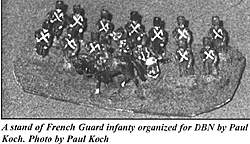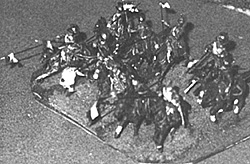I spoke with Mike about this over dinner. Remarking that very few fresh ideas had come into the war gaming rule writing Fraternity in recent years. I was looking for a set of rules that would not remove figures (to retain visual appeal), not use rosters (too much fudging and too much work) yet be simple and extremely fast.
DBA or De Bellis Antiquitatis came to mind as filling the bill except in the visual category. Mike and I then threw around the idea of doubling base size in both width and depth and mounting fairly large numbers of figures on the new larger bases. For example in the DBA rules Pike Infantry mount 4 25mm figures on a 60mm by 20mm stand. We would make a stand 120mm by 40mm and mount 12 to 18 figures on it in some sort diorama manner. The visual effect should be stunning.
You may of course play the following with almost any base system as long as they are of uniform width, but this is what I did and it looks really nice.
Infantry: All line and elite close order infantry are mounted on stands 120mm by 60mm. I use between 14 and 18 figures per stand.
Light infantry: Again the stand is 120mm by 60mm but only 10 or 12 figures in skirmish order.
Artillery: Bases the same 120 by 60. I use two guns and crew of 6 to 10 figures.
Cavalry: I took a slight departure from DBA here. By the time of Napoleon both light and heavy cavalry formed in similar if not identical formations, thus all horse mount 8 to 10 figures on a 120mm by 80mm base. These really look cool!
Generals:MOVEMENT
Element movement rates are as follows:
As per DBA scale equals 1 pace to 1mm.
Fire is conducted as per missle fire in DBA. Melee is stand to stand contact. All elements have two values, a FIRE FACTOR and a CLOSE COMBAT FACTOR. They are as follows:
*Artillery fires only on opponents bound
Fire Modifiers
Fire Ranges
Melee Table
The tactical factors used in DBA must changed a little. Any reference to auxilia or Pisoli should refer to Light Infantry. Also any reference to bows over lapping, etc., should.be ignored. Mounted elements should also receive a -2 against Infantry in square.
Use the DBA Table but with the following results:
IF SCORE IS LESS THAN ENEMY TOTAL, BUT MORE THAN HALF:
IF SCORE IS LESS THAN HALF THE ENEMY:
BRITISH: 6 infantry, 1 light infantry, 1 artillery, 2 light cavalry, 1 heavy cavalry; 1 Cuirassier (household cavalry etc) or 1 light infantry.
AUSTRIAN: 7 infantry, 1 light infantry; 1 light infantry or 1 light cavalry, 1 infantry, 1 lancer; or 1 cuirassier, 1 artillery, 1 dragoon.
RUSSIAN: 6 infantry, 1 light infantry, 1 artillery; 1 artillery or 1 dragoon or 1 lancer; 1 cuirassier or 1 lancer.
FRENCH: 5 infantry, 1 light infantry, 1 artillery, 1 light cavalry, 1 dragoon, 1 cuirassier; 1 horse artillery or 1 dragoon, or 1 lancer; 1 guard infantry or 1 light infantry.
 Last Yearís trip to Historicon brought forth a number of ideas. One came while watching the DBA tournament run by my good friend Mike McVeigh. I was struck by the simplicity, but subtlety of the rules. It was all very impressive except visually. A couple of dozen figures simply does not produce the pageantry I have looked for since turning my back on Avalon Hill all those many years ago.
Last Yearís trip to Historicon brought forth a number of ideas. One came while watching the DBA tournament run by my good friend Mike McVeigh. I was struck by the simplicity, but subtlety of the rules. It was all very impressive except visually. A couple of dozen figures simply does not produce the pageantry I have looked for since turning my back on Avalon Hill all those many years ago.
 It was not until my return trip to the deserts of Arizona, actually on the return flight, that I began thinking about an old article I had read in Wargames Illustrated. It described the use of DBA for other periods. Well, I remount my 22mm Napoleonic collection about once year any way so an idea was born. I would use DBA for Napoleonics but with the stand and corresponding scale increases. The following was what I came up with. It has thus far proved both visually pleasing and fun to play.
It was not until my return trip to the deserts of Arizona, actually on the return flight, that I began thinking about an old article I had read in Wargames Illustrated. It described the use of DBA for other periods. Well, I remount my 22mm Napoleonic collection about once year any way so an idea was born. I would use DBA for Napoleonics but with the stand and corresponding scale increases. The following was what I came up with. It has thus far proved both visually pleasing and fun to play.
Stand Sizes
Infantry 200 Paces
Light Infantry 300 Paces
Artillery 200 Paces
Horse Artillery 400 Paces
Heavy Cavalry 400 Paces
Light Cavalry 500 Paces
Infantry forms square by declaring so at itís bound. It takes up 1 movement point.
FIRE & MELEE
Unit Fire
FactorClose
CombatINFANTRY 3 3 LIGHT INFANTRY 2 2 ARTILLERY* 5 1 CUIRASSIERS 0 4 DRAGOONS 2 3 LIGHT HORSE 1 2 LANCERS 1 3 Elites +1
Canister +2
Artillery at a square 2 diceMusket 300 Paces
Carbine 200 Paces
Foot Artillery (Ball) 1000 Paces
Foot Artillery (Cannister) 500 Paces
Horse Artillery (Ball) 800 Paces
Horse Artillery (Cannister) 400 PacesInfantry & Light Infantry : Destroyed by Cuirassiers if in good going,, otherwise recoil.
Artillery : Destroyed by any contact.
Cuirassier : Destroyed by Light Horse, or Artillery or if in bad going, otherwise recoil.
Dragoons : Destroyed by Artillery or if in bad going, otherwise recoil.
Light Horse : Destroyed if in bad going, otherwise recoil.Light Horse : Destroyed by mounted or if in bad going, otherwise flee 600 paces.
Light Foot : Destroyed by Mounted if in good going or by Light Foot, otherwise flee 600 paces.
Others : Destroyed.
NOTE: If any Cavalry push back or destroy an enemy element in close combat they must follow up by one (1) base depth.SAMPLE ARMIES
Back to Table of Contents -- Courier #82
To Courier List of Issues
To MagWeb Master Magazine List
© Copyright 2001 by The Courier Publishing Company.
This article appears in MagWeb (Magazine Web) on the Internet World Wide Web.
Other military history articles and gaming articles are available at http://www.magweb.com